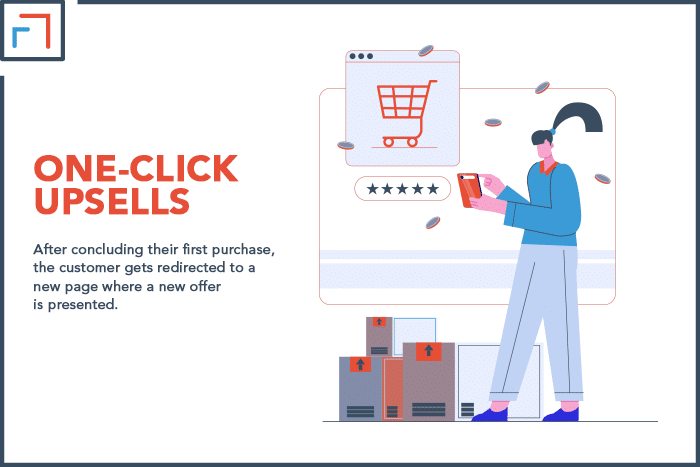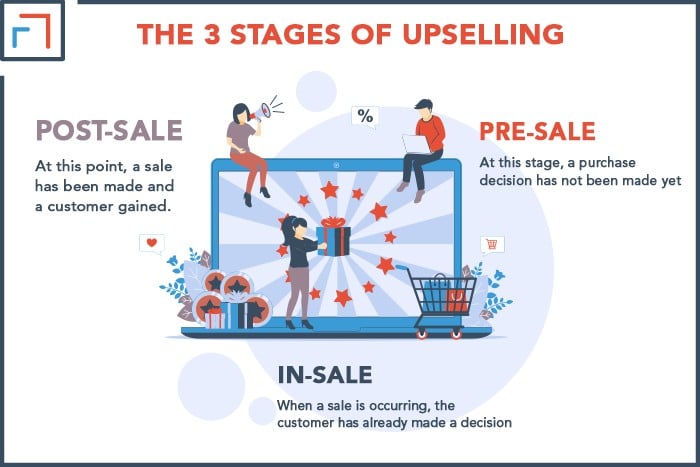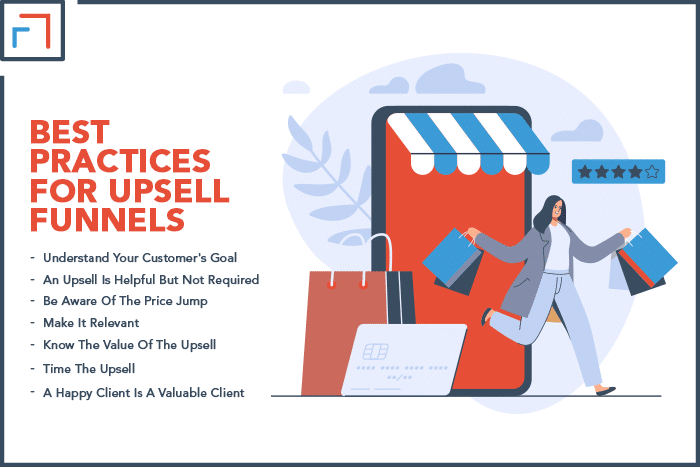Upsell Funnels follow the marketing practice of providing customers with an increased value in exchange for a higher purchase price. Upselling is a core principle for increasing sales and customer happiness.
An upsell funnel is a type of funnel that offers upgrades or complimentary products or services to a customer. Online businesses use this tool to maximize profits by adding value for their customers. The upsell funnel encourages customers to buy more quickly and conveniently.
While the concept of upselling funnels may look simple, some tactics must be applied to make upselling successful. This article will explore how upsell funnels work, why businesses use them, and some best practices to keep in mind when making upsells.
What Is Upselling?
Upselling is when a business provides a complementary (or upgraded) product that will provide more value to the customer while increasing the business profit. While upselling, you are essentially making more money by spending the same amount on customer acquisition that you would for the original intended purchase.
The language involved in marketing practices can be a bit abstract, so picture this:
You’re hungry and decide you want some fast food. So you enter the place, pick your favorite burger, soda, and fries, and right before you pay, the cashier asks you…
“Would you like to enlarge your fries for $0.99?”
That’s a real-life example of upselling.
You may have been going there only for a burger, but since the cashier suggested the bigger option, you figure you might as well get it because it is cheap and convenient for you.
As a result, you get more fries, and the business gets more money, so this is a win-win scenario for all parties involved!
In fact, an upsell funnel is one of the best sales funnels for an eCommerce brand.
Upsell Funnels – Adding Upsells Into Your Funnels
Including upsells in your funnels is a must if you want to maximize profit per customer.
The most popular ways to include this practice are by adding ‘Order Bumps’ and ‘One-Click Upsells’.
1. Order Bumps
An Order Bump is the upsell option that you often see at the end of your checkout page during the order summary.
It’s usually showcased as a little square right below the order button, which states an additional offer and its core benefit in just a few words.
The customer accepts the upsell by simply ticking a box and proceeding with the payment.
2. One-Click Upsells
A One-Click Upsell occurs right after the purchase has taken place. Another name for this upsell is ‘The One Time Offer (OTO)’.
After concluding their first purchase, the customer gets redirected to a new page where a new offer is presented.
The business has more space to showcase the offer and all its benefits. Once on this page, the customer is a single click away from taking the offer or declining it (hence the name).

3. The Downsell
A downsell is an offer that’s presented to a customer after they have declined an upsell. It is usually a lower-priced version of the initial upsell.
4. The Free Trial
Some businesses can offer free trials or test drives to their customers depending on the product.
This lets them showcase the value of their products without any commitments on the customer’s side.
In addition, free trials provide a better customer experience by reducing buying pressure.
By the end of a free trial, an upsell is made to the customer that encourages them to upgrade to the paid plan or product.
The 3 Stages Of Upselling
Upselling might occur in three different stages of a purchase. It’s important to define these stages before we start including upsells into our funnels.
Pushing extra purchases at the wrong time can do more harm than good.
1. Pre-Sale
At this stage, a purchase decision has not been made yet. Instead, the prospect reviews their options and considers the relationship between the price and value of a product.
An upsell at this stage will show a comparison between the customer’s current option and the business option (with increased value at a slightly higher price).
2. In-Sale
When a sale is occurring, the customer has already made a decision. Offering them another option might confuse him or discourage them from buying altogether.
At this stage, the best upsell would be to offer a complementary product or service to solve an additional concern the prospect might have.
3. Post-Sale
At this point, a sale has been made, and a customer gained. Returning buyers are the lifeblood of a business, so it’s important to make them happy.
Therefore, upsells at this stage will include not just additional products or services but a premium version of a product or service that was already purchased.

Skyrocket Your Sales with These KILLER Upselling Strategies
As you can see, implementing the right upselling strategy will require some planning and a clear understanding of your customer journey.
So, let’s cover some best practices and recommendations to help you time your message and strategy.
1. Understand Your Customer’s Goal
We must know the needs and expectations a customer might have before offering any upgrade or additional offer.
Taking time to understand the needs and problems of our customers will lead to increased customer satisfaction.
2. An Upsell Is Helpful But Not Required
You don’t want to make the upsell a requirement for the main product or service to fulfill its function.
If your customer feels forced to buy the upsell, the profit might increase, but customer satisfaction will decrease. This tradeoff defeats the whole purpose of the upsell.
3. Be Aware Of The Price Jump
As a rule of thumb, you shouldn’t be offering an upsell with a cost greater than 25% of the original purchase.
Most customers will have a budget designated for a specific product or service.
So if there’s a significant price jump from the original cost, they won’t even consider taking your upsell.
4. Make It Relevant
Depending on your product or service, your customers might want more of what they are buying or an option that enhances their experience.
This is the difference between the pizza place offering you a two-for-one deal and a burger place upgrading your fries.
Everyone wants another slice of pizza but rarely a second burger.
5. Know The Value Of The Upsell
It’s important that you know how the upsell will benefit your customer so you can share it with them in a convincing manner.
Most people won’t hesitate to buy something they believe will help them, even if it means spending an extra buck or two.
6. Time The Upsell
Make sure you are upselling the right product at the right time. You already know the 3 stages of an upsell, so use it in your favor!
7. A Happy Client Is A Valuable Client
Some businesses might be incentivized to increase profits instead of customer satisfaction. This is short-term thinking.
If you want to make the most out of every customer, focus on providing the greatest value upfront and reaping the rewards over a longer period of time.

Don’t Throw in a One Fits All Upsell Offer
Upselling funnels are an effective way to increase profits and overall customer happiness when executed well.
Upsells work best in the right context, so make sure you understand what would be most valuable for your customer before presenting them with a new offer.
Segregate your customers into relevant and similar groups before throwing them an offer which makes most sense for the group they’re in.
Keeping the best practices in mind will help you create successful upsell tactics to add to your funnels!
